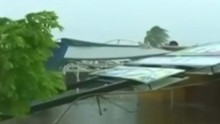Hurricane Patricia weakens, but still 'extremely dangerous'
Hurricane Patricia weakened to a Category 4 storm Friday night with maximum sustained winds of 130 mph, but remained "extremely dangerous" over southwestern Mexico, the National Hurricane Center said. Patricia made landfall hours earlier as a Category 5 storm, the fiercest.
[Previous story, published at 10:24 p.m. ET]
(CNN) -- Hurricane Patricia -- the strongest hurricane ever recorded -- made landfall on Mexico's Pacific coast Friday evening, its 165 mph winds barreling into southwestern Mexico near Cuixmala, officials said.
The monster storm touched down about 6:15 p.m., hours after weakening slightly with sustained winds decreasing to 190 mph and gusts to 235 mph, according to the U.S National Weather Service.
Even then, Patricia lashed the coast with fierce winds and rain as residents and tourists in resorts such as Puerto Vallarta and Manzanillo sought shelter.
Patricia landed about 55 miles west-northwest of Manzanillo, home to the largest container port on Mexico's Pacific seaboard.
Taking the brunt of the hurricane are small fishing villages about 130 miles south of Puerto Vallarta, which had braced for potentially catastrophic 200 mph sustained winds and torrential rains. Despite the slight weakening, damage from the Category 5 storm is expected to be devastating.
Less than an hour after its arrival, Patricia churned inland over southwestern Mexico with maximum sustained wind speeds of 160 mph and was still "extremely dangerous," according to the American weather service.
Patricia hit luxury resorts and impoverished fishing villages with equal ferocity.
It struck land near Cuixmala, a 25,000-acre private estate of beach, jungle, nature reserve and fruit plantations that was once home to the late British billionaire James Goldsmith, according to the estate's website. Its Moorish-style villas, with rates starting at $900 a night, have hosted visitors such as Richard Nixon and Ronald and Nancy Reagan.
"I'm a little worried," said Carlos Cisneros, an estate worker staffing the phones Friday night. "The rain is intense and the wind picks up at times for about five minutes, then subsides. It comes and goes."
Cisneros said there were mandatory evacuations in nearby communities where landslides are possible, but he and others at the sprawling estate had to come to work.
"It's not so bad right now," said Cisneros, a receptionist at a nearby sister property, Hacienda de San Antonio. "I took a risk."
Anthony Perez, a representative of Save the Children in Mexico City, said Patricia will be a huge challenge for Mexico's government.
"We have these wonderful luxurious tourist destinations but then there's half the population that's living in different degrees of poverty," he said.
"A lot of these homes, especially in the rural areas, are made of flimsy materials, and with the wind being so strong and then there being so much rain, the potential for landslides. Many of these families will probably be losing everything."
Mexico's National Commission for Water, CONAGUA, said the eye of Patricia has a diameter of 10 kilometers, or 6.21 miles.
President Enrique Peña Nieto, in a tweet, said: "Hurricane Patricia is on the coast of Mexico. Do not go outside. Protect yourselves and follow instructions from Civil Protection. I am thinking of you all."
The excessive wind speeds, according to the head of the Mexican agency that includes its national weather service, could make Patricia the most dangerous storm in his nation's history.
"The hurricane is so big and so intense that it has the capacity to pass over both the Sierra Madres in our country -- that is, through our most mountainous ranges -- and then exit the country on the other side into the north part of the Gulf of Mexico and possibly the United States," CONAGUA director Robert Ramirez de la Parra said.
The closest contender to its size, at this point, might be Hurricane Camille, which battered the U.S. Gulf Coast in 1969. Patricia looks to be more powerful than that storm, as well as stronger than Hurricane Andrew in 1992, Katrina in 2005 and many others.
It already has surpassed them in one way: its central pressure reading -- the weight of the air above a system -- which is a key measure of any storm's strength.
Live updates on Hurricane Patricia
The midday Friday central pressure recording of 879 millibars (the barometric pressure equivalent is 25.96 inches) "is the lowest for any tropical cyclone globally for over 30 years," according to the Met Office, Britain's weather service.
Patricia's intensity is comparable to Typhoon Haiyan, which hit the Philippines in 2013, the World Meteorological Organization tweeted. More than 6,000 people died in Haiyan, due largely to enormous storm surges that rushed through coastal areas.Haiyan had 195 mph sustained winds when it made landfall, while Typhoon Tip was at 190 mph (and had a slightly lower pressure reading of 870 millibars) in 1979.
News Courtesy: www.cnn.com











